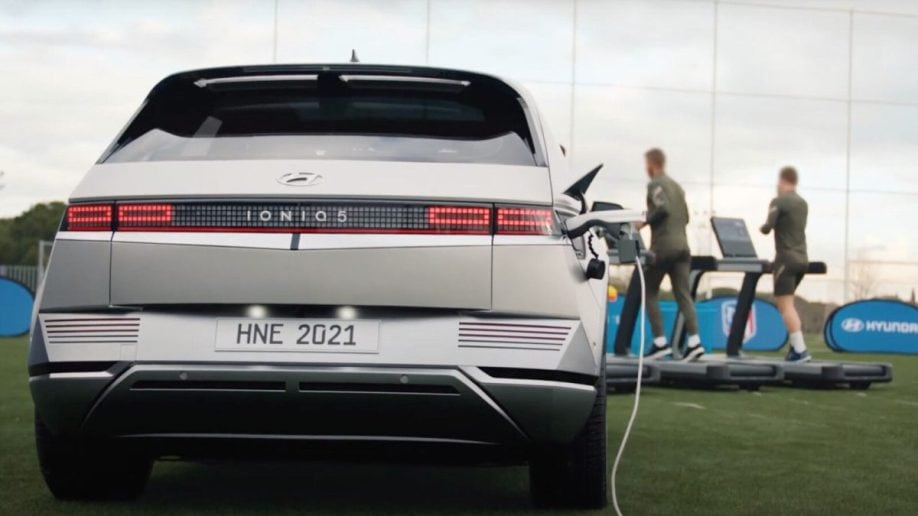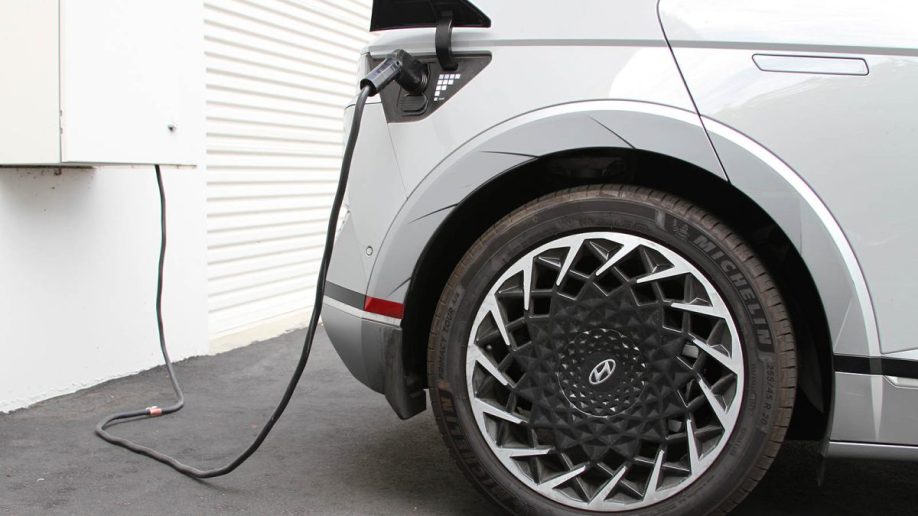The Hyundai Ioniq 5 is an innovative all-electric car with a distinct design and a starting price of $44,100 for the 2025 model year. Built on the Electric Global Modular Platform (e-GMP), this compact SUV is one of the fastest-charging electric vehicles available today.
Keep reading for instructions on how to charge an Ioniq 5.
- Hyundai Ioniq Battery Options
- How to Charge a Hyundai Ioniq
- Fast Charging
- Where to Charge the Hyundai Ioniq 5
Hyundai Ioniq 5 Battery Options
The base model 2025 Hyundai Ioniq 5 SE Standard Range has a 63-kilowatt-hour (kWh) battery. Earlier models had 58-kWh battery capacity. This base version is rear-wheel drive (RWD) with a total range of up to 245 miles on a full charge. The standard battery charges from 10% to 100% in roughly five-and-a-half hours using a Level 2 charger connected to a 240-volt outlet.
The SEL and Limited trim levels have a longer-range, 84-kWh battery. These are available in rear-wheel-drive (RWD) and all-wheel-drive (AWD) models. The RWD option has an estimated total range of 318 miles, while the estimated range for the AWD model is 290 miles. The XRT trim, which adds some off-road credibility, is rated at 259 miles on a full charge. The larger battery takes about seven hours and 20 minutes to charge on a Level 2 charger.
Vehicle-to-Load Feature
You can tap into the battery power of your Ioniq 5 with vehicle-to-load (V2L) capability. This V2L feature lets you power other electric devices via the Ioniq 5’s battery. The innovative technology is great when you’re on the go and need to provide power to things like camping gear, scooters, projectors, phones, laptops, or even another EV.
A power converter connects to the exterior charging port or the outlet under the rear seats. It uses the battery’s stored energy to offer up to 3.6-kilowatts (kW) of electricity. This feature works even when the vehicle is turned off.
The V2L connector is not included when you buy a new Ioniq 5, but you may purchase the accessory separately.
MORE: Electric Car Rebates and Incentives: What to Know by State
How to Charge a Hyundai Ioniq 5

Shift the vehicle into “P,” apply the parking brake, and turn off the car. There are multiple ways to open the charging port door. You can touch and push the door surface, press the button on the left side of the dashboard, or use voice recognition if you’ve previously set this up on the MyHyundai Bluelink mobile app. From there, connect the charging cable, and press and hold the charging door open/close button for two seconds to start charging.
The estimated charging time will appear on the dashboard. When your charging session is complete, or you need to get back on the road, press the unlock button on your keyfob twice to stop the charging (or use the Tesla app, if using a Supercharger) and unlock the connector. Remove the connector and return it to the charging station holster. Press the door close button to close the charging port door.
Pro Tip: Enable “battery conditioning” through the infotainment system 15-20 minutes before getting to the charging station to prepare the battery and get the fastest charge.
At-Home Charging
Level 1: A portable 120-volt charging cord is included with the purchase of a new Hyundai Ioniq 5. This charger connects to a standard household outlet and provides between six and 12 amps of power. Level 1 charging is significantly slower than other charging options.
This “trickle charger” method will only increase your battery level by minimal amounts, even when plugged in overnight. The portable charger can take 40 hours or more to charge the standard battery from empty to full.
Level 2: A Level 2 charging station is recommended for routine, at-home charging. This setup requires a 240-volt outlet on a dedicated circuit. It feeds an alternating current (AC) to your battery, providing a faster and more consistent charge than a standard 120-volt household connection. It will take a low battery five hours and 40 minutes to charge the standard range battery to 100%. The long-range battery takes more than seven hours to reach 100% using a Level 2 charger.
At-home Level 2 charging stations require professional installation by a licensed electrician. Hyundai recommends home chargers above 10-kW for the Ioniq 5. The electrician will need to install a 60-amp breaker in your electrical panel to accommodate the power output.
If you live in an apartment building or other multi-unit dwelling, consult your property manager for available options. Many complexes are installing charging stations for residents as electric vehicles become more common in these residential spaces.
RELATED: EV Charging Etiquette Guide
Public Charging
The newest Ioniq 5 models feature a native NACS charging port, which is the type of connection used at Tesla’s Supercharger network. Hyundai provides a J1772-to-NACS adapter so you can plug into nearly any Level 2 public charger. The automaker also supplies a CCS-to-NACS adapter to use at DC fast charging stations equipped with the CCS standard. Earlier Ioniq 5 models have CCS charging ports.
Level 2: When you’re out and about, Level 2 public chargers are generally easy to find. Look for them in busy areas like grocery store parking lots, shopping centers, office parks, and outside major hotel chains. Check the Bluelink app for help locating a public charging station in your area.
Level 3: DC fast chargers are widely accessible and also stationed in populated areas around the country and interstate exits. New Ioniq 5 drivers have many more charging opportunities with the vehicle’s NACS charging port, which allows them to seamlessly use the robust Supercharger network of chargers. DC fast chargers feed a direct current (DC) to your battery for a more immediate boost. Fast chargers are great for road trips and long-haul drives. However, Hyundai states battery performance and durability can deteriorate if DC chargers are used constantly. For good battery health, plan to use a Level 2 AC connection as your primary charging method. This best practice will help keep your high-voltage battery in “optimal condition.”
RELATED: How Much Does It Cost to Charge an Electric Car?
Fast Charging
The Hyundai Ioniq 5 is one of the fastest-charging electric cars on the market today, boasting an 800-volt charging capability. When connected to a 350-kW DC ultra-fast charger, it can go from 10% to 80% state of charge in as little as 20 minutes. If you’re especially short on time, you can still boost the battery by 62 miles in roughly five minutes using a high-voltage fast charger, depending on the original state of charge.
Charging speed and time estimates will vary depending on multiple factors, including the outdoor temperature, current battery levels, vehicle settings, and more.
Where To Charge the Ioniq 5

You can charge the Ioniq 5 at home via your residential charging station setup or at public charging stations. Just look for the NACS charger, attach the charger directly or use the CCS adapter, and power up.
When you buy or lease a new Ioniq 5, you can choose between a home Level 2 charger or a $400 public-charging credit to use at any of the more than 25,000 ChargePoint charging locations in the U.S.
Editor’s Note: This article has been updated since its initial publication. Chantel Wakefield contributed to the report.

